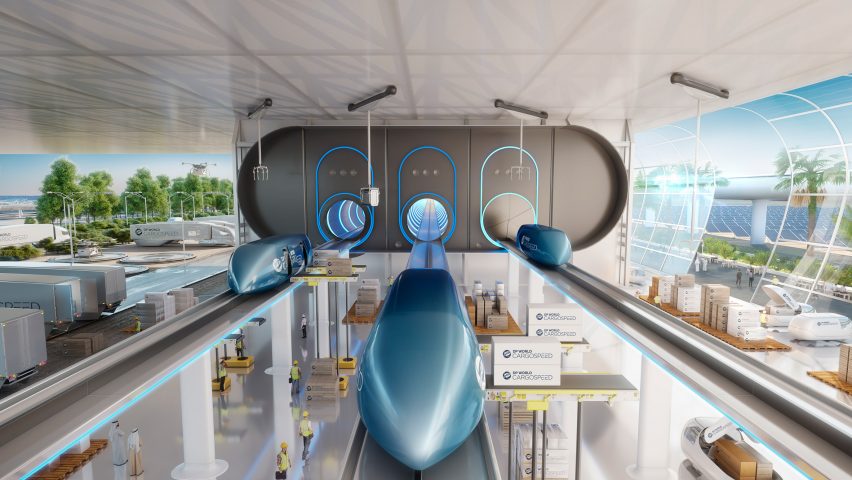For our review of 2018, deputy editor Tom Ravenscroft looks at the year's biggest trends in architecture and interior design, including action to address gender imbalance, the rise of hyperloop and the move towards off-grid living.
Vision of a hyperloop future
With the prospect of high-speed travel networks made up of vacuum tubes getting closer to reality, architects have started drawing up plans for how hyperloop will change our transport infrastructure.
Among the most impressive proposals were UNStudio's concept for hyperloop stations and Foster + Partners' vision for a hyperloop cargo network (both pictured). Meanwhile, Priestmangoode created a full-scale prototype of a Hyperloop capsule and Designworks revealed interiors of the Dubai Hyperloop passenger capsule.
A-listers move into architecture
This year saw numerous A-list celebrities taking an interest in architecture. Kanye West led the way by taking a step towards translating his long-held architectural ambitions into reality, with the first output of Yeezy Home is expected to be a social housing venture.
Elon Musk also looked to be making a move into architecture with plans to create bricks to be used in low-cost housing, while Dwayne Johnson – widely known as the Rock – stared in a film about a skyscraper.
Unfinished interiors back in vogue
Less has been more for many interior designers this year, with unfinished surfaces appearing in homes, cafes, and restaurants around the world.
Raw concrete walls were left exposed in numerous establishments, including this stripped-back coffee shop in Kobe by Yusuke Seki, a pasta bar in Melbourne, a Japanese restaurant in Quebec City and Woods Bagot's self-designed studio in New York.
Action to address gender imbalance
In the wake of the MeToo campaign and numerous sexual scandals, architecture's focus was placed firmly on the actions need to address the profession's continuing gender imbalance. Dezeen launched the Move the Needle initiative to improve gender equality, while the UK government made the the country's largest studios reveal their gender-pay disparity.
Elizabeth Diller, who was included on this year's Time 100 list, said the industry was undergoing a dramatic change, while Odile Decq, Farshid Moussavi and Manuelle Gautrand protested against discrimination in architecture at the Venice biennale.
However, the deep issues facing the industry were highlighted when the architecture world was rocked by a string of sexual harassment accusations levelled at Pritzker Prize-winning architect Richard Meier.
Forensic Architecture wins awards
In 2018, the architecture profession focused on wider issues impacting the world, which was embodied by the work of UK-based investigative agency Forensic Architecture. The research group created a 3D video of Grenfell Tower fire and showed the public its work at an exhibition at the ICA in London.
A nomination for the Turner Prize, the UK's biggest art prize followed, along with the researchers winning the Design of the Year award for 2018.
3D-printed buildings finally here
After a long build-up, buildings are now being 3D printed. In Milan CLS Architetti and Arup used a portable robot to 3D print a house, while the US military used 3D printing to build a concrete barracks. Other 3D-printed projects include a garden pavilion alongside a house in China and a bridge 3D printed from metal, which was unveiled at Dutch Design Week.
Looking to the future, plans were announced to build the "world's first" 3D-printed houses that people will live inside, and NASA revealed the winners of its competition to design a 3D-printed habitat on Mars.
Spy museums opening everywhere
The year saw spy museums open in New York and and the Alps. In America David Adjaye completed the Spyscape museum of espionage, while at the precipice of a mountain in Sölden, Austria, Johann Obermoser's cantilevered museum dedicated to James Bond opened to the public.
For those interested in even more espionage, the Rogers Stirk Harbour + Partners-designed International Spy Museum in Washington DC is scheduled to open next year.
Co-working gains momentum
As office culture and working patterns continue to evolve, co-working spaces have been popping up all over our major cities. In London, WeWork, which now employs Bjarke Ingels as its chief architect, opened within Stirling's No 1 Poultry, while nightclub the Ministry of Sound also made a move into co-working.
Other shared working spaces included an aquamarine co-working space in Warsaw, a homely space in Copenhagen and a co-working space in a former brewery in Brno, Czech Republic. Female-only co-working spaces also opened, in Toronto and within an old Brooklyn paper factory.
Indoor arches are on-trend
This year arched forms have increasing been used in interior spaces. In shops, arches were used by Apparatus to define spaces in a Los Angeles showroom to resemble moody paintings, and by Spanish studio Clap at a kids shoe store in Valencia.
Arches also appeared in a dim-sum eatery in Hong Kong, the Bar Lotus in Shanghai, and numerous residential projects including a Parisian pied-à-terre, pair of Tribeca lofts and coral-pink Barcelona apartment.
Off-grid homes become popular
The increasingly levels of technology in our lives is leading many people to seek a less complex life and either live, or holiday, in off-grid homes.
An off-grid home alongside a loch was named RIBA House of the Year 2018, while a prefabricated home with a micro-farming wall was showcased at the United Nations Headquarters and Slovakian firm Nice Architects created a ggg-shaped micro home for off-griders.
For those looking for a brief escape, off-grid holiday homes surrounded by speculator scenery appeared in the southern California desert, on the border between Turkey and Greece, and in the Cairngorms National Park in Scotland.

